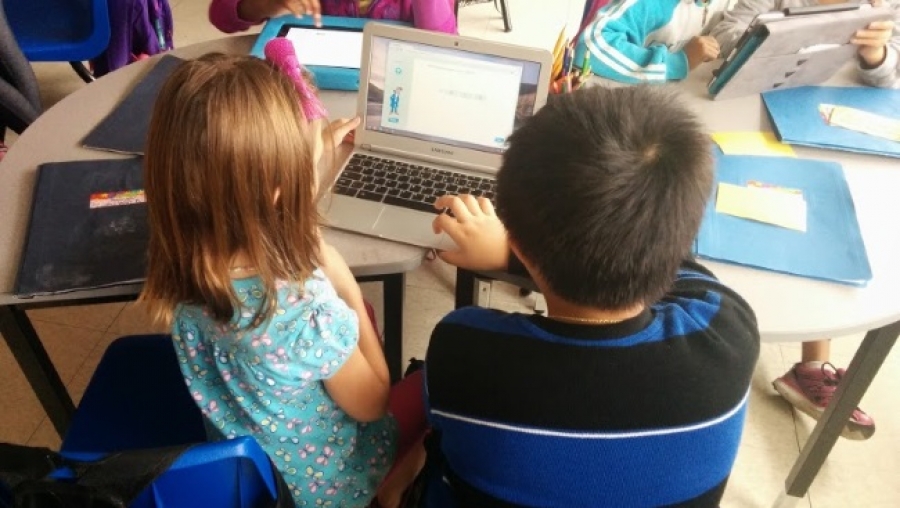We are in our first full year of 1:1 at our school, St. Anthony Catholic in Ottawa. We will be using a combination of Chromebooks, iPads and iPods ,and every student will have access to a device every day. Our Junior students (grades 4-6) will be required to bring their devices home every night. This is very important in our community – many families do not have computers, and by sending our machines home we are trying to empower families as well as individual students.
The next challenge will be to make sure all families have good internet access.
We started with some training last year in preparation for 1:1. We worked on Google tools, and our staff is now comfortable with Google Drive, Docs, Groups and a number of important apps like Read and Write. We connected to Discovery Education, and we really hope to have access to the Science Techbook for all our students this year.
My main concern as the principal is to continue to offer high-quality training and support for all staff, so that it is easy to make a complete switch to using devices every day in meaningful ways throughout the year. We need to start our year with services in place that will provide the resources and training that teachers will need to make integration happen at a meaningful level.
It is one thing – pretty easy – to supply every child with a device. It is a far more difficult thing to provide the individualised training each staff member needs to make implementation effective. Wherever staff start the year on the SAMR scale, it will be important to see movement as the year progresses.
So, how do we meet this challenge?

Our School Improvement Plan emphasis is digital integration, but teachers need direction on how to find resources. We need a resource that is flexible and allows teachers to continue learning at their own pace throughout the year. We need a system that respects the adult learner and allows easy access to excellent material. In my opinion, it is not good enough to simply direct teachers to go to YouTube and ‘look it up’. I believe that as education leaders we need to supply teachers with credible resources that teachers can easily access.
I think there is an argument for making services available that offer excellent customer service and good content in one easy to find location.
One service we are considering is Simple K-12. The good thing about Simple K-12 is that so many good resources are collected in one spot and I recognise many of the presenters from Twitter. It is a credible depository of a huge number of webinars given by professionals in the field, and encourages teachers to network and move through different levels or badges as they become more comfortable with the service. It also encourages teachers to contribute to the Simple K-12 blog and share their learning with a wide network of educators.
Discovery Education is another important service. I went to their principals’ conference in Washington this summer (DENSI 2015) and it was excellent. I met administrators from across the United States and learned a great deal about the challenges and opportunities they face in their districts. I really hope that I will be able to develop these contacts as part of my PLN throughout the year.

Like Simple K-12, Discovery is very keen about facilitating networks of educators. They offer a valuable additional service beyond the digital, and do an excellent job at supporting educators as they develop new teaching methods that rely more and more on digital resources. They offer a uniquely human touch as part of their service. The DEN is a network of educators supported by Discovery that encourages people to connect on-line and participate in annual conferences like DENSI 2015.
Another service we are looking at is Atomic Learning. Like Simple K-12, it has a huge catalogue of resources to choose from. Teachers who take part in sessions can also take part in an assessment afterwards and redo portions of the session they didn't get first time. It also comes with a feature that allows principals to monitor the learning of teachers.
Teachers with accounts can also enrol their own classes and also assign them lessons to work on – for example a teacher can assign an Evernote lesson to students to do at home then practice with the tool in the classroom. This not only encourages the use of the computer in the classroom but also provides opportunities for flipped learning. Teachers can monitor the use of the learning tool by students.
Atomic also provides examples of Maker Lessons - something I have yet to see anywhere else. This is something we could really use – like 1:1, we have made the investment in equipment, but we need teaching resources to help support the implementation of maker technology.

Principals can also set up training sessions for staff to follow selecting from a wide variety of sessions. Lessons can be broken down into ‘atoms’ as short as one-two minutes - teachers or students do not have to watch the entire lesson.
The problem with these services is that they can be expensive. We could easily spend our entire school budget on these two services.
Relying on free resources is not the answer. We need access to resources that are credible and designed specifically for educators. We also can’t afford to waste teachers’ time searching on their own for good services to use.
To be fair, everyone is busy and it takes time to find resources that are capable of offering excellent professional development and customer service. Once the resources are found, administrators need to be trained on them first before they are introduced to staff.
This means that there needs to be a plan that starts with the administrator and focuses on professional development first. Individual schools should not be left to fend for themselves when it comes to searching for the best resources. We also need to find solutions that do not focus on training one or two staff members. To expect that training a few people with the hope that their experiences will translate to an entire staff are simply not realistic.
So, what is an administrator to do? To be honest, I am not sure. Really good professional development is an expensive investment. If we expect 1:1 initiatives to work we will have to make greater investments in excellent services. What is the solution for our school? I’m still working on that.
Are you a 1:1 school? Share your stories and tips below.


















